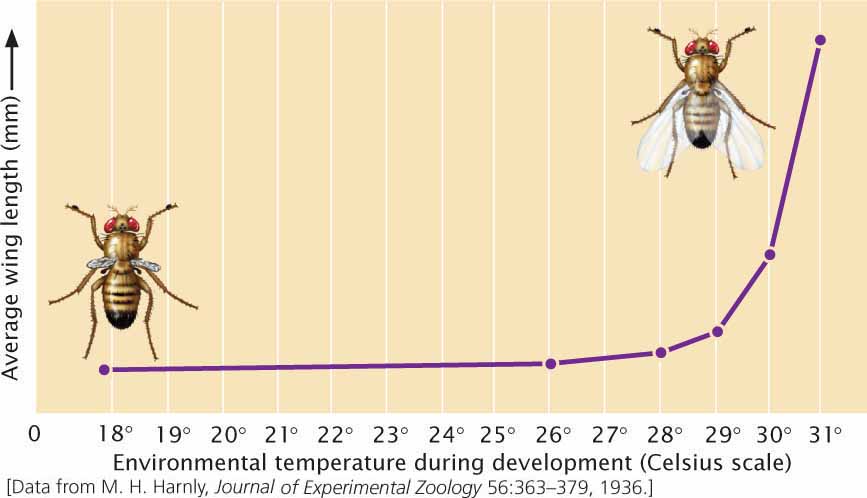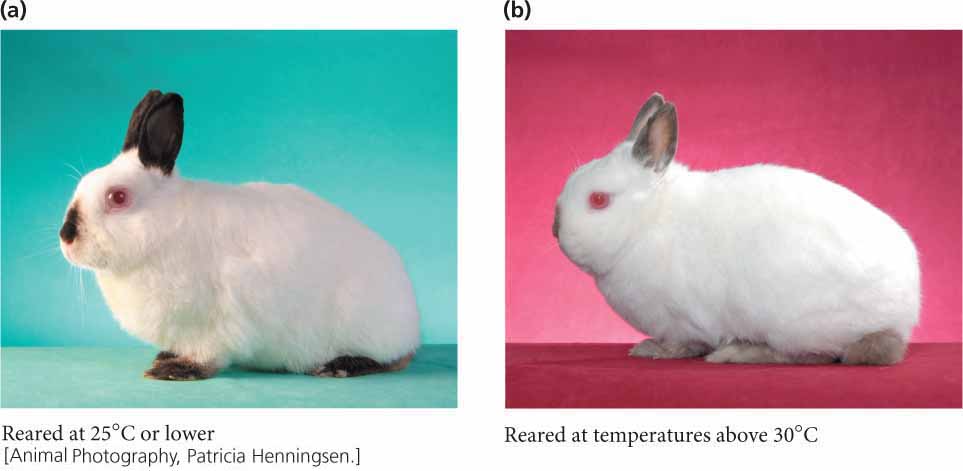5.5 The Expression of a Genotype May Be Affected by Environmental Effects
In Chapter 3, we learned that each phenotype is the result of a genotype developing within a specific environment; each genotype may produce several different phenotypes, depending on the environmental conditions in which development takes place. For example, a fruit fly homozygous for the vestigial mutation (vg vg) develops reduced wings when raised at a temperature below 29°C, but the same genotype develops much longer wings when raised at 31°C (Figure 5.19).

For most of the characteristics discussed so far, the effect of the environment on the phenotype has been slight. Mendel’s peas with genotype yy, for example, developed green seeds regardless of the environment in which they were raised. Similarly, persons with genotype IAIA have the A antigen on their red blood cells regardless of their diet, socioeconomic status, or family environment. For other phenotypes, however, environmental effects play a more important role.
127
Environmental Effects on the Phenotype
The phenotypic expression of some genotypes critically depends on the presence of a specific environment. For example, the himalayan allele in rabbits produces dark fur at the extremities of the body—on the nose, ears, and feet (Figure 5.20). The dark pigment develops, however, only when a rabbit is reared at a temperature of 25°C or lower; if a Himalayan rabbit is reared at 30°C, no dark patches develop. The expression of the himalayan allele is thus temperature dependent; an enzyme necessary for the production of dark pigment is inactivated at higher temperatures. The pigment is restricted to the nose, feet, and ears of a Himalayan rabbit because the animal’s core body temperature is normally above 25°C and the enzyme is functional only in the cells of the relatively cool extremities. The himalayan allele is an example of a temperature-sensitive allele, an allele whose product is functional only at certain temperatures. Similarly, vestigial wings in Drosophila melanogaster are caused by a temperature-dependent mutation (see Figure 5.19).

Environmental factors also play an important role in the expression of a number of human genetic diseases. Phenylketonuria (PKU) is due to an autosomal recessive allele that causes intellectual disability. The disorder arises from a defect in an enzyme that normally metabolizes the amino acid phenylalanine. When this enzyme is defective, phenylalanine is not metabolized, and its buildup causes brain damage in children. A simple environmental change, putting an affected child on a low-phenylalanine diet, prevents the development of intellectual disability.
These examples illustrate the point that genes and their products do not act in isolation; rather, they frequently interact with environmental factors. Occasionally, environmental factors alone can produce a phenotype that is the same as the phenotype produced by a genotype; this phenotype is called a phenocopy. In fruit flies, for example, the autosomal recessive mutation eyeless produces greatly reduced eyes. The eyeless phenotype can also be produced by exposing the larvae of normal flies to sodium metaborate.
CONCEPTS
The expression of many genes is modified by the environment. A phenocopy is a trait produced by environmental effects that mimics the phenotype produced by the genotype.
 CONCEPT CHECK 12
CONCEPT CHECK 12
How can you determine whether a phenotype such as reduced eyes in fruit flies is due to a recessive mutation or is a phenocopy?
The Inheritance of Continuous Characteristics
So far, we’ve dealt primarily with characteristics that have only a few distinct phenotypes. In Mendel’s peas, for example, the seeds were either smooth or wrinkled, yellow or green; the coats of dogs were black, brown, or yellow; blood types were of four distinct types, A, B, AB, or O. Such characteristics, which have a few easily distinguished phenotypes, are called discontinuous characteristics.
Not all characteristics exhibit discontinuous phenotypes. Human height is an example of such a characteristic; people do not come in just a few distinct heights but, rather, display a wide range of heights. Indeed, there are so many possible phenotypes of human height that we must use a measurement to describe a person’s height. Characteristics that exhibit a continuous distribution of phenotypes are termed continuous characteristics. Because such characteristics have many possible phenotypes and must be described in quantitative terms, continuous characteristics are also called quantitative characteristics.
Continuous characteristics frequently arise because genes at many loci interact to produce the phenotypes. When a single locus with two alleles encodes a characteristic, there are three genotypes possible: AA, Aa, and aa. With two loci, each with two alleles, there are 32 = 9 genotypes possible. The number of genotypes encoding a characteristic is 3n, where n equals the number of loci, each with two alleles, that influence the characteristic. For example, when a characteristic is determined by eight loci, each with two alleles, there are 38 = 6561 different genotypes possible for this characteristic. If each genotype produces a different phenotype, many phenotypes will be possible. The slight differences between the phenotypes will be indistinguishable, and the characteristic will appear continuous. Characteristics encoded by genes at many loci are called polygenic characteristics.
128
The converse of polygeny is pleiotropy, in which one gene affects multiple characteristics. Many genes exhibit pleiotropy. Phenylketonuria, mentioned earlier, results from a recessive allele; persons homozygous for this allele, if untreated, exhibit intellectual disability, blue eyes, and light skin color. The lethal allele that causes yellow coat color in mice also is pleiotropic. In addition to its lethality and effect on coat color, the gene causes a diabetes-like condition, obesity, and increased propensity to develop tumors.
Frequently, the phenotypes of continuous characteristics are also influenced by environmental factors. Each genotype is capable of producing a range of phenotypes. In this situation, the particular phenotype that results depends on both the genotype and the environmental conditions in which the genotype develops. For example, only three genotypes may encode a characteristic, but, because each genotype produces a range of phenotypes associated with different environments, the phenotype of the characteristic exhibits a continuous distribution. Many continuous characteristics are both polygenic and influenced by environmental factors; such characteristics are called multifactorial characteristics because many factors help determine the phenotype.
The inheritance of continuous characteristics may appear to be complex, but the alleles at each locus follow Mendel’s principles and are inherited in the same way as alleles encoding simple, discontinuous characteristics. However, because many genes participate, because environmental factors influence the phenotype, and because the phenotypes do not sort out into a few distinct types, we cannot observe the distinct ratios that have allowed us to interpret the genetic basis of discontinuous characteristics. To analyze continuous characteristics, we must employ special statistical tools, as will be discussed in Chapter 24.  TRY PROBLEM 45
TRY PROBLEM 45
CONCEPTS
Discontinuous characteristics exhibit a few distinct phenotypes; continuous characteristics exhibit a range of phenotypes. A continuous characteristic is frequently produced when genes at many loci and environmental factors combine to determine a phenotype.
 CONCEPT CHECK 13
CONCEPT CHECK 13
What is the difference between polygeny and pleiotropy?